Kochab, Beta Ursae Minoris (β UMi), is an orange giant star located in the constellation Ursa Minor. With an apparent magnitude of 2.08, it is the second brightest star in Ursa Minor, after Polaris. Kochab lies at a distance of 130.9 light years from Earth. It is one of the seven stars that form the Little Dipper. The star hosts a confirmed exoplanet, Beta Ursae Minoris b, discovered in 2014.
Star type
Kochab is an orange giant of the spectral type K4 III. It has a mass 2.2 times that of the Sun. As it evolved away from the main sequence, it has expanded to a size of 42.06 solar radii. With a surface temperature of 4,030 K, Kochab has a bolometric luminosity 390 times that of the Sun, but most of its energy output is in the invisible infrared. The star is a slow spinner, with a projected rotational velocity of only 8 km/s. Its estimated age is 2.95 billion years.
Kochab is a mild barium star, which indicates that it may have an undetected white dwarf companion. Barium stars are typically components in binary systems where the other component was once a carbon star on the asymptotic giant branch (AGB) and transferred some of its matter onto the companion when the latter was still on the main sequence. The AGB star has since reached the end of its life cycle, while the companion has evolved away from the main sequence.
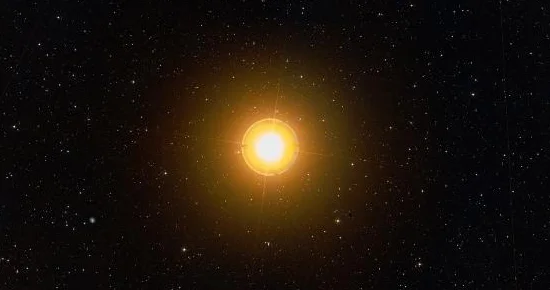
Kochab (Beta Ursae Minoris), image: Wikisky
A 2008 study used data obtained with the Solar Mass Ejection Imager (SMEI) on the Coriolis satellite over a period of three years and found that the star’s luminosity varies over a period of about 4.6 days. The study also suggested that earlier estimates of the star’s mass, which were in the range from 2 to 2.5 solar masses, may have been too high, and gave a lower mass estimate of 1.3 ± 0.3 solar masses.
Planet
In 2014, Kochab was announced to have a gas giant planet, designated Beta Ursae Minoris b, orbiting it at a distance of 1.4 ± 0.1 astronomical units. Detected using the radial velocity method, the planet has a mass of at least 6.1 Jupiter masses and orbits the host star with a period of 522.3 ± 2.7 days and an eccentricity of 0.19.
The team that detected the planet estimated a radius of 38.3 ± 1.1 R⊙ and a mass of 1.4 ± 0.2 M⊙ for Kochab.
Facts
Kochab and its neighbour Pherkad are known as the Guardians of the Pole. The two stars always circle Polaris, the star that marks true north and always appears in the same position in the sky.
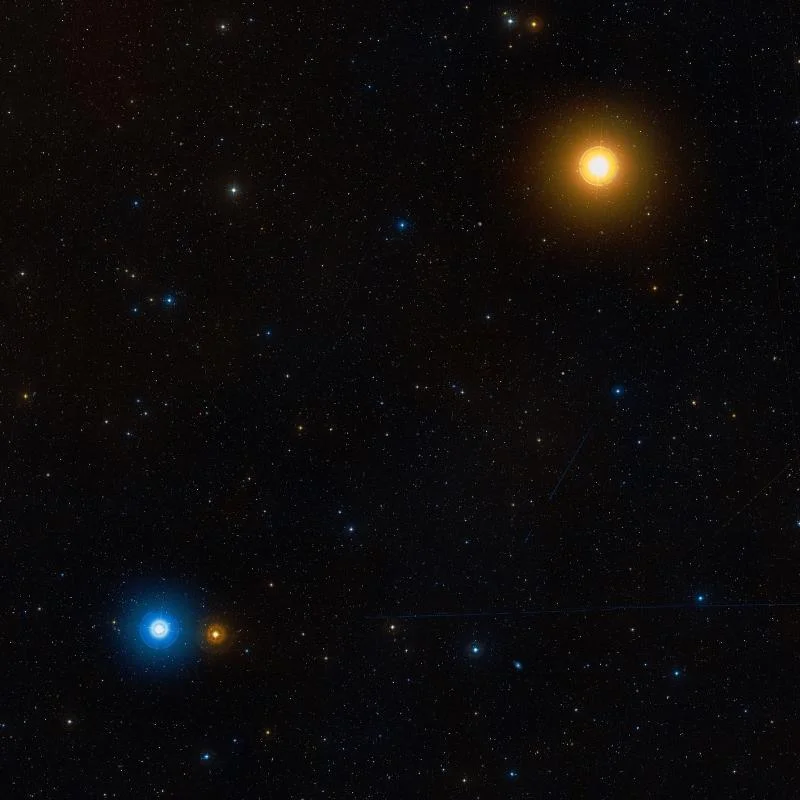
Pherkad and Kochab, image: Wikisky
Kochab is one of the bright stars that take their turn as the North Star over the course of Earth’s 26,000-year precession cycle. It last shared the title with Kappa Draconis in the neighbouring constellation Draco from around the year 1700 BCE to about 300 CE. The two stars took over from Thuban in Draco. However, as Kochab never came within less than 7 degrees of the pole, it was not seen as the marker of true north. Kappa Draconis, similarly, only came within 6 degrees. In comparison, Polaris will come within only 0.5 degrees of the pole around the year 2100.
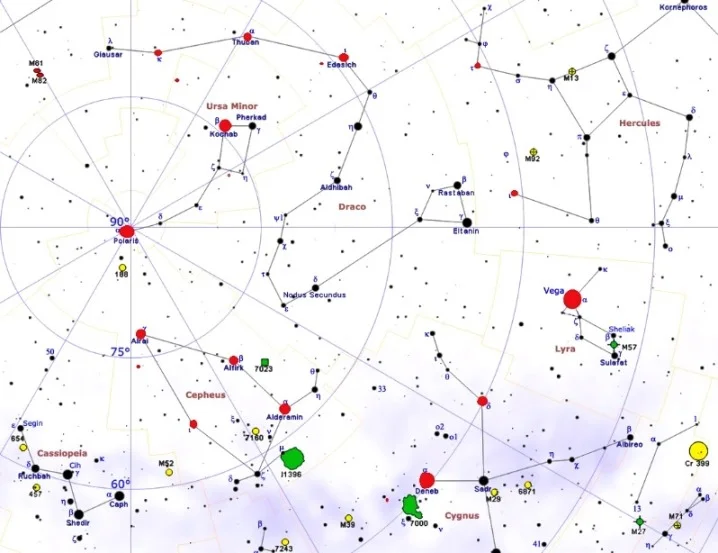
North Stars (marked red), image: Roberto Mura
In the era of the Roman Empire, the north celestial pole was about halfway between Kochab and Polaris and, in the early Middle Ages, it drifted closer to Polaris, our current North Star. Polaris will keep the title until about 3000 CE, at which point the pole will have moved halfway to Errai (Gamma Cephei) in the constellation Cepheus.
Kochab had become important in navigation even before it was the nearest bright star to the north celestial pole. Around the year 2500 BCE, Thuban had moved away from the pole and Kochab became one of the stars used to find true north. In the year 2467 BCE, the pole was aligned exactly between Kochab and Mizar, the middle star in the handle of the Big Dipper. Ancient Egyptians called the two stars “the indestructibles” and associated them with the afterlife of a pharaoh. They aligned pyramids toward the north, believing that pharaohs joined northern circumpolar stars after their passing. The Great Pyramid of Giza, built around 2,480 BCE, was aligned with the straight line passing through the north celestial pole.
After 2000 BCE, Kochab was commonly used in navigation with Pherkad, the other outer star of the Little Dipper’s bowl.
The radiant of the annual Ursid meteor shower, which occurs from December 17 to 26, is located near Kochab.
Kochab is part of the Little Dipper, an asterism formed by seven relatively bright stars of Ursa Minor: Polaris (Alpha Ursae Minoris), Kochab (Beta Ursae Minoris), Pherkad (Gamma Ursae Minoris), Epsilon Ursae Minoris, Zeta Ursae Minoris, Yildun (Delta Ursae Minoris), and Eta Ursae Minoris. Polaris, Yildun and Epsilon Ursae Minoris form the Dipper’s handle, while Kochab, Pherkad, Zeta and Eta Ursae Minoris form the bowl.
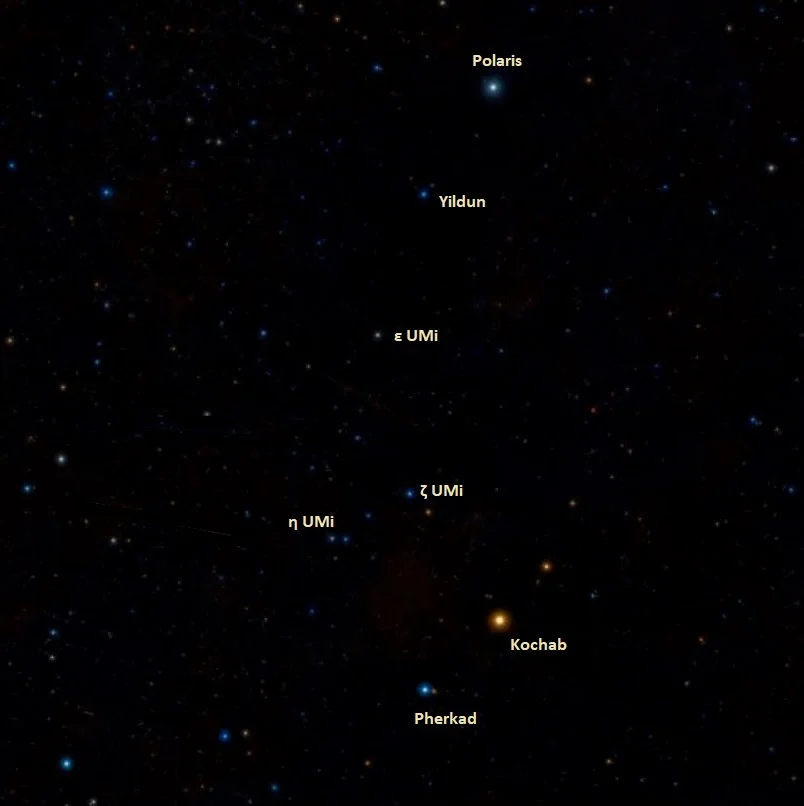
Little Dipper, image: Wikisky
Unlike the Big Dipper, the Little Dipper is not easy to see from light-polluted areas since its central stars are not particularly bright. Polaris, Kochab and Pherkad are easily spotted in less-than-ideal conditions, but the inner four stars are all fainter than magnitude 4.00 and require clear, dark skies to be seen.
Kochab and the slightly brighter Polaris have a special status in the field of celestial navigation. They are the only navigational stars in Ursa Minor. They belong to a group of 11 northern navigational stars with a declination between 30° N and 90° N. Other stars in this group are Capella in the constellation Auriga, Mirfak in Perseus, Schedar in Cassiopeia, Deneb in Cygnus, Eltanin in Draco, Vega in Lyra, and Alioth, Dubhe and Alkaid in Ursa Major.
On average, Kochab is the 57th brightest star in the sky. It is only slightly fainter than Alpheratz and Mirach in the constellation Andromeda. It is about as bright as Saiph in Orion, Menkent in Centaurus, and Rasalhague in Ophiuchus, and it just outshines Tiaki in Grus, Algol in Perseus, and Almach in Andromeda.
Kochab sometimes outshines Polaris and becomes the brightest star in Ursa Minor. Polaris is a Cepheid variable and its brightness varies from magnitude 1.86 to 2.13. Even though it is at least 200 light years more distant than Kochab, Polaris is normally brighter because it is much more intrinsically luminous, shining with an output of 1,260 Suns.
Name
The origin of the name Kochab (pronunciation: /ˈkoʊkæb/) is uncertain. The name appeared during the Renaissance period and has also been spelled Kocab and Kochah. It may be derived from the Arabic al-kawkab, denoting a celestial body (a planet or a star), from the phrase Al Kaukab al Shamaliyy (al-kawkab al-šamāliyy), meaning “the north star.” This was a reference to the fact that, in ancient times, Kochab was closer to the north celestial pole than Polaris.
Another possibility is that the name is derived from Alrucaba, a name that applied to the constellation. In the Alphonsine Tables, Beta Ursae Minoris was called Reicchabba. The 15th century Timurid astronomer Ulugh Beg called it Anwar al Farkadain, “the bright one of the two calves.” (The dimmer one was Pherkad, Gamma Ursae Minoris.)
The name Kochab was approved by the International Astronomical Union’s (IAU) Working Group on Star Names (WGSN) on July 20, 2016.
The Chinese know Kochab as 北極二 (Běi Jí èr), the Second Star of North Pole. The Chinese North Pole asterism is formed by Kochab, Pherkad, 5 Ursae Minoris, 4 Ursae Minoris, and Σ 1694 (Struve 1694) in the neighbouring constellation Camelopardalis. The asterism is part of the Purple Forbidden Enclosure, one of the Three Enclosures in Chinese astronomy. The Purple Forbidden Enclosure is found in the region around the north celestial pole. It represents the imperial palace. Kochab represents the Emperor, while Pherkad symbolizes the Crown Prince.
Location
Kochab is very easy to find because it is part of a familiar star pattern, the Little Dipper. It is the brightest star in the Dipper’s bowl and marks the front hip of Ursa Minor, the Smaller Bear.
The Little Dipper can be found using the stars of the Big Dipper’s bowl. The two outer stars of the bowl, Merak and Dubhe, are known as Pointer Stars because they point the way to Polaris and true north. Polaris is the first relatively bright star along the imaginary line extended from Merak through Dubhe to the north. Kochab is the brighter of the two outer stars of the Little Dipper’s bowl.
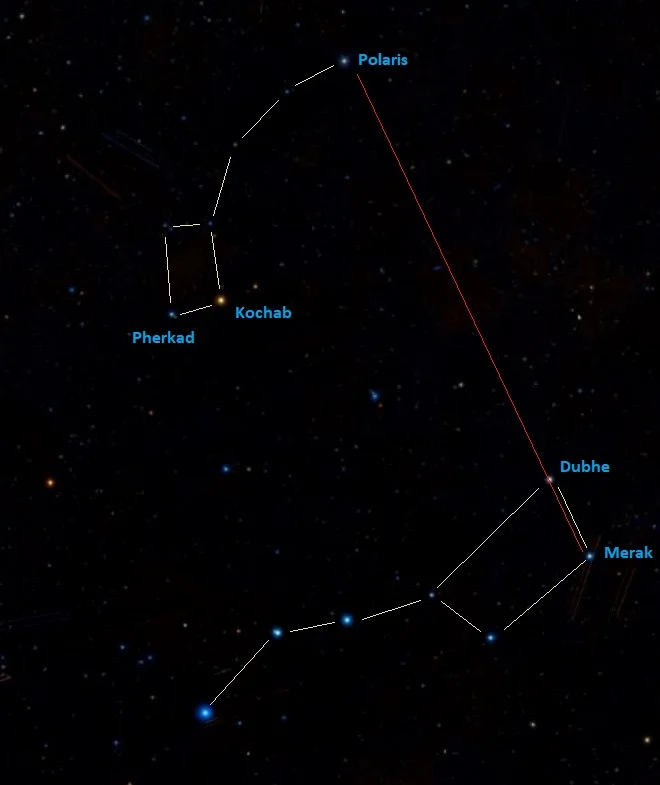
The Little Dipper and Big Dipper, image: Wikisky
If the inner stars of the Little Dipper are not visible, Kochab and Pherkad can be identified as two relatively bright stars that are roughly parallel to Mizar and Alioth, the two stars in the Big Dipper’s handle closest to the bowl.
Kochab can be used to find the spiral galaxy NGC 5836, which appears close to the star. The galaxy has an apparent magnitude of 13.9 and lies about 327 million light years away.
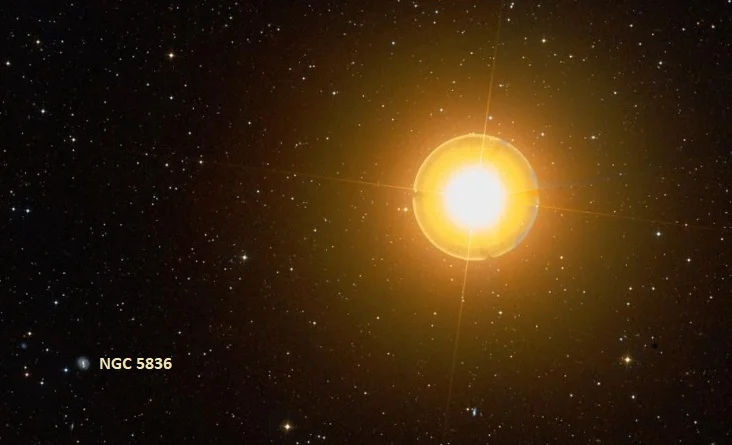
Kochab and NGC 5836, image: Wikisky
Constellation
Kochab is located in the constellation Ursa Minor. Representing the Little Bear, Ursa Minor is one of the most recognizable constellations in the sky. Its brightest stars form the Little Dipper, a distinctive asterism visible from areas without too much light pollution.
Associated with a bear or wagon since ancient times, Ursa Minor is one of the 48 Greek constellations, first catalogued by the Greek astronomer Claudius Ptolemy in his Almagest in the 2nd century CE. As the northernmost of the 88 constellations, Ursa Minor has traditionally played an important role in navigation. The constellation’s seven brightest stars pointing to true north are the reason why the Latin word for “north” is septentrio, derived from septem triones (“seven oxen”).
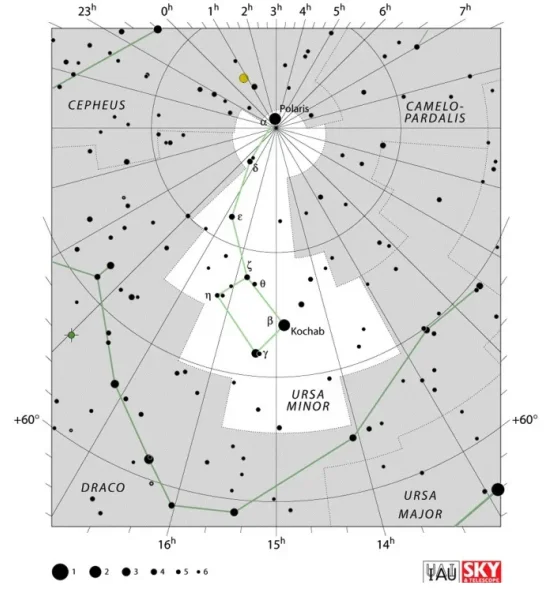
Ursa Minor constellation map by IAU and Sky&Telescope magazine
Ursa Minor is one of the smaller constellations, only the 56th in size out of 88, stretching across 256 square degrees of the far northern sky. It is best known for being home to the Little Dipper and the yellow-white supergiant Polaris, the North Star.
Other notable stars in Ursa Minor include the variable white giant Pherkad (Gamma UMi), the orange giant Theta Ursae Minoris, the spectroscopic binary system Epsilon Ursae Minoris, the variable carbon star Z Ursae Minoris, and the semiregular variable red giants Lambda Ursae Minoris, R Ursae Minoris and RR Ursae Minoris. Ursa Minor is also home to the X-ray source Calvera (1RXS J141256.0+792204), one of the nearest neutron stars to Earth, and to the peculiar star H1504+65, the hottest white dwarf known, with a surface temperature of 200,000 K.
Interesting deep sky objects in Ursa Minor include the Ursa Minor Dwarf, a relatively bright (mag. 11.9) dwarf spheroidal galaxy, the active supergiant elliptical radio galaxy NGC 6251, the barred spiral galaxy NGC 6217, and the galaxy known as Polarissima Borealis (NGC 3172), the closest NGC object to the north celestial pole.
For observers north of the equator, Ursa Minor is circumpolar, i.e. it never falls below the horizon and can be seen throughout the year. The constellation is largely invisible from the southern hemisphere, except for locations close to the equator.
The best time of year to observe the stars and deep sky objects in Ursa Minor is during the month of June. The entire constellation is visible from locations between the latitudes 90° N and 10° S.
The 10 brightest stars in Ursa Minor are Polaris (Alpha UMi, mag. 1.86 – 2.13), Kochab (Beta UMi, mag. 2.08), Pherkad (Gamma UMi, mag. 3.05), Epsilon Ursae Minoris (mag. 4.19), 5 Ursae Minoris (mag. 4.253), Zeta Ursae Minoris (mag. 4.32), Yildun (Delta UMi, mag. 4.36), RR Ursae Minoris (mag. 4.44 – 4.85), 4 Ursae Minoris (mag. 4.80), and Eta Ursae Minoris (mag. 4.95).
Kochab – Beta Ursae Minoris
| Spectral class | K4 III |
| Variable type | Suspected |
| U-B colour index | +1.78 |
| B-V colour index | +1.47 |
| Apparent magnitude | 2.08 |
| Absolute magnitude | −0.83 ± 0.010 |
| Distance | 130.9 ± 0.6 light years (40.1 ± 0.2 parsecs) |
| Parallax | 24.91 ± 0.12 mas |
| Radial velocity | +16.96 ± 0.19 km/s |
| Proper motion | RA: -32.61 ± 0.11 mas/yr |
| Dec.: +11.42 ± 0.13 mas/yr | |
| Mass | 2.2 ± 0.3 M☉ or 1.4 ± 0.2 M☉ |
| Luminosity | 390 ± 25 L☉ |
| Radius | 42.06 ± 0.91 R☉ |
| Temperature | 4,030 K |
| Metallicity | -0.29 dex |
| Age | ~2.95 billion years |
| Rotational velocity | 8 km/s |
| Surface gravity | 1.83 cgs |
| Constellation | Ursa Minor |
| Right ascension | 14h 50m 42.32580s |
| Declination | +74° 09′ 19.8142″ |
| Names and designations | Kochab, Beta Ursae Minoris, β UMi, 7 Ursae Minoris, HD 131873, HR 5563, HIP 72607, FK5 550, SAO 8102, BD+74°595, GC 20029, GCRV 8646, PPM 8758, GSC 04416-01799, PLX 3373.00, AG+74 412, JP11 2549, IRAS 14508+7421, 2MASS J14504235+7409199, UBV 12983, TYC 4416-1799-1, CCDM J14506+7410A, IDS 14510+7434 A, WDS J14507+7409A |